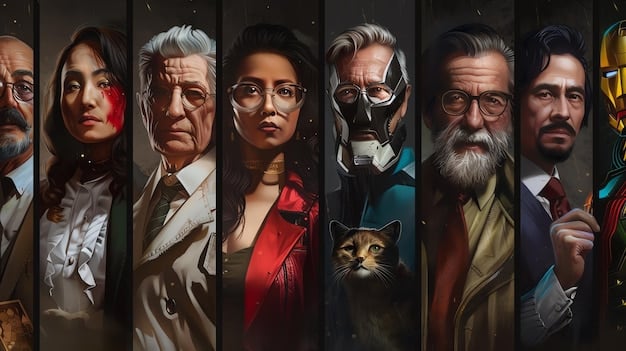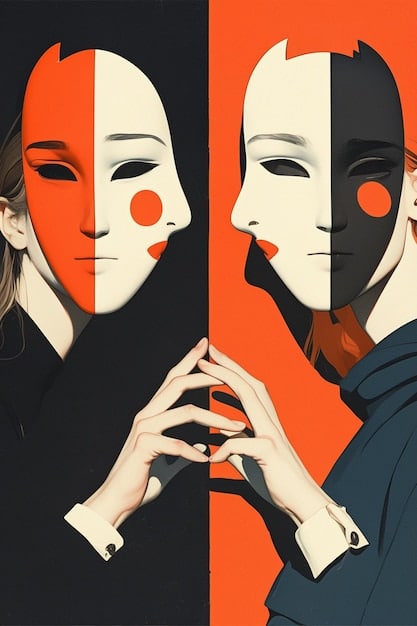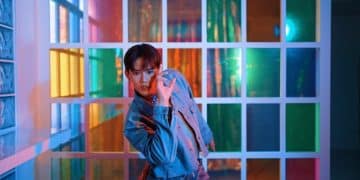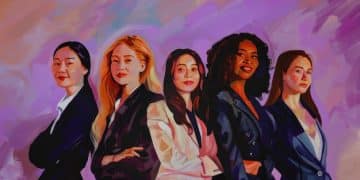BL (Boys’ Love) Dramas in 2025: Genre Review & Impact

The Rise of BL (Boys’ Love) Dramas: A Review of the Genre’s Representation and Impact in 2025 explores how these dramas have evolved, their cultural significance, and their influence on viewers in the United States, focusing on representation and storytelling trends.
The cultural landscape of television has been constantly evolving, and one of the most intriguing developments has been the rise of **The Rise of BL (Boys’ Love) Dramas: A Review of the Genre’s Representation and Impact in 2025**. This genre, originating in East Asia, has steadily gained a global following, and it’s worthwhile taking a look at where it’s heading.
Boys’ Love Dramas: A Quick Look
Boys’ Love (BL) dramas, at their core, tell love stories between male characters. Originating in Japanese manga, they’ve expanded into various media, including live-action dramas. With a growing fanbase in the US, it’s crucial to understand their increasing presence in 2025.
The initial appeal often lies in the genre’s focus on relationships and emotions, frequently exploring themes of acceptance, identity, and overcoming challenges. BL dramas provide a space for narratives centered on love and connection outside of traditional heterosexual norms.

Origins and Evolution
BL’s roots in Japanese manga have significantly shaped the early tropes and themes. However, as the genre has spread, it has begun to adapt and evolve according to diverse cultural contexts. Thai BL dramas, for example, have introduced a unique blend of humor and sentimentality, contributing to the genre’s global popularity.
Key Elements of BL
Several elements are typical in the BL genre, including an emphasis on emotional intimacy, the exploration of societal expectations, and characters who challenge traditional masculinity. Through these elements, viewers often engage with themes of self-discovery and acceptance, making BL dramas particularly resonant for LGBTQ+ audiences and allies.
- Emotional narrative drives the storyline, emphasizing character development.
- Many storylines deal with societal prejudices and familial expectations.
- Characters often break conventional molds of gender expression.
As BL dramas progress into 2025, they will continue to diversify in terms of storytelling and representation. Increased attention will be paid to creating more authentic and nuanced character portrayals, moving away from stereotypes.
Representation in BL Dramas: Progress and Pitfalls
Representation is a complex topic within the BL genre, and examining it is crucial for understanding its cultural impact. While BL dramas have provided visibility for same-sex relationships, it’s important to consider the quality and depth of this representation.
Historically, BL dramas have been criticized for leaning into stereotypes, such as the “uke” and “seme” dynamics, which establish specific roles for male characters that can be limiting or problematic. However, there is a growing consciousness within the industry about the need to move beyond these tropes and to create more nuanced, well-rounded characters.
Positive Developments in Representation
Recent years have seen significant improvements in representation. Some dramas are consciously including LGBTQ+ actors in lead roles, adding authenticity and lived experience to the portrayal of queer relationships. Additionally, storylines are becoming more complex, tackling themes like mental health, family acceptance, and societal discrimination with greater sensitivity.

Challenges and Common Pitfalls
Despite improvements, several challenges remain. The fetishization of gay relationships by straight creators and audiences remains a concern. Additionally, the lack of diversity in terms of race, ethnicity, and body type is still evident in many BL dramas. It’s essential for the genre to broaden its scope and include a wider range of stories and experiences to be more inclusive and representative.
- Stereotypical characterizations can perpetuate harmful tropes.
- Fetishization undermines authentic representation.
- The lack of racial and ethnic diversity limits the genre’s reach.
Moving forward, the BL genre must continue to challenge ingrained biases and actively seek diverse voices both in front of and behind the camera. By doing so, it can move towards more respectful and empowering representations of LGBTQ+ individuals and relationships.
BL Dramas and Cultural Impact in the US
BL dramas are making a noticeable splash in the US, where they attract diverse audiences drawn by heartfelt narratives and compelling characters. Their popularity reflects changing attitudes toward LGBTQ+ stories and a desire for more inclusive content in mainstream media.
One of the key aspects of BL dramas’ appeal is their ability to explore universal themes of love, identity, and self-acceptance through the lens of same-sex relationships. This focus resonates with many viewers, who find comfort and validation in seeing their experiences represented on screen.
Fan Culture and Community
BL dramas have fostered vibrant online communities in the US, with fans actively engaging in discussions, sharing fan art, and organizing events centered around their favorite shows. These communities provide a space for viewers to connect with like-minded individuals and celebrate their shared love for the genre.
Influence on Mainstream Media
The growing popularity of BL dramas is also influencing mainstream media in the US. Streaming platforms are increasingly recognizing the demand for LGBTQ+ content, and some are beginning to produce or acquire BL dramas for their platforms. This increased visibility could lead to broader acceptance and normalization of same-sex relationships in the media landscape.
- Online communities provide a space for discussion and sharing.
- Shows are now more accessible through mainstream platforms.
- Increased visibility normalizes same-sex relationships.
BL dramas are not only providing entertainment but are also contributing to important conversations about representation and inclusivity. Their cultural impact in the US is likely to continue to grow as the genre becomes more mainstream and accessible to diverse audiences.
The Future of BL: Trends to Watch in 2025
As the BL genre moves forward, several trends are poised to shape its future. One of the most significant trends is the push for greater diversity and complexity in storytelling.
In 2025, we can expect to see more BL dramas that tackle complex social issues, explore diverse cultural contexts, and feature characters with multifaceted identities. These dramas will move beyond simple romance tropes to offer richer and more meaningful narratives.
Increased International Collaboration
Another trend to watch is the increasing collaboration between production companies in different countries. As BL dramas become more globally popular, we will likely see more co-productions that bring together talent from different cultures, resulting in stories that appeal to a wider international audience.
Technological Advancements
Technological advancements, such as virtual reality (VR) and augmented reality (AR), could also play a role in the future of BL dramas. Imagine being able to immerse yourself in the world of your favorite BL drama through a VR experience or interacting with characters through AR technology. These innovations could create new opportunities for fan engagement and storytelling.
- More diverse and complex narratives are on the horizon.
- International collaborations promise cross-cultural content.
- Technology may provide immersive experiences.
The future of BL dramas looks bright, with innovation, diversity, and technological advancements all contributing to the genre’s continued growth and evolution. By embracing these trends, BL dramas can continue to captivate audiences and make a positive impact on the media landscape.
Criticism and Common Misconceptions About BL
Despite its growing popularity, the BL genre is not without its critics. Many concerns and misconceptions surround BL, which must be addressed to promote a deeper understanding of the genre.
One common critique is that BL often caters to a female gaze, potentially fetishizing gay relationships rather than portraying them authentically. While this critique is valid, it is important to recognize that the genre is evolving, with more creators actively working to challenge and subvert such tropes.
Addressing Misconceptions
Another misconception is that BL dramas promote harmful stereotypes about gay men. While some early BL dramas did rely on stereotypical characterizations, many contemporary dramas strive to create more nuanced and well-rounded characters who defy expectations. It is essential to approach BL dramas with a critical eye and to appreciate the diversity of stories and representations within the genre.
Navigating Sensitive Content
Some viewers are also concerned about the portrayal of sensitive content, such as non-consensual relationships or abusive dynamics, in BL dramas. While such content is not representative of the genre as a whole, it is crucial to be aware of these issues and to engage with BL dramas responsibly, paying attention to content warnings and trigger warnings.
- Catering to the female gaze can lead to fetishization.
- Stereotypes persist despite evolving characterizations.
- Sensitive content requires responsible engagement.
By addressing these criticisms and misconceptions, we can foster a more informed and nuanced appreciation of the BL genre, recognizing both its potential and its limitations.
How to Engage with BL Dramas Responsibly
As BL dramas become more accessible to mainstream audiences, it is important to engage with the genre responsibly, ethically, and respectfully. Responsible engagement involves being mindful of the cultural context, supporting diverse creators, and challenging problematic tropes.
One important aspect of responsible engagement is to seek out BL dramas created by LGBTQ+ individuals and allies. These creators often bring unique perspectives and lived experiences to their stories, resulting in more authentic and nuanced representations of queer relationships.
Supporting Diverse Creators
Another way to engage with BL dramas responsibly is to support diverse representation both on and off-screen. This means seeking out dramas that feature characters from different racial, ethnic, and cultural backgrounds and advocating for greater diversity in casting and production crews.
Challenging Problematic Tropes
It is just as crucial to challenge problematic tropes and stereotypes when they arise in BL dramas. This can involve engaging in critical discussions online, providing constructive feedback to creators, and advocating for more responsible and ethical storytelling practices.
- Seeking out LGBTQ+-created content ensures authenticity.
- Supporting diverse representation promotes inclusivity.
- Challenging problematic tropes improves storytelling.
By engaging with BL dramas in a responsible and thoughtful manner, we can help contribute to a more inclusive and respectful media landscape.
| Key Element | Brief Description |
|---|---|
| 💖 Emotional Narratives | Focuses on character-driven plots and in-depth feelings. |
| 🏳️🌈 Representation | Shows diverse LGBTQ+ characters challenging societal norms. |
| 🤝 Community Impact | Fosters online discussions and influences media perceptions. |
| 🌐 Future Trends | More diverse plots, global collaborations, and VR integration. |
Frequently Asked Questions
▼
BL dramas, short for Boys’ Love dramas, are television series that primarily focus on romantic relationships between male characters. Rooted in Japanese manga, they explore various themes and emotional dynamics.
▼
They offer unique storytelling perspectives on love, identity, and acceptance. This resonates with American audiences seeking diverse narratives and authentic representations of relationships often unseen in mainstream media.
▼
Initially, BL dramas used stereotypes. Now, there’s a growing focus on nuanced characters, LGBTQ+ actors, and complex narratives tackling real-world issues like mental health and discrimination more responsibly.
▼
Common critiques include potential fetishization of gay relationships, reliance on harmful stereotypes, and the inclusion of sensitive content. Creators continuously need critical input to address and improve these issues.
▼
Support LGBTQ+ creators and productions, advocate for diverse casts, and challenge harmful tropes. This fosters inclusivity and promotes more respectful and authentic storytelling across the genre.
Conclusion
As we look ahead to 2025, **the Rise of BL (Boys’ Love) Dramas: A Review of the Genre’s Representation and Impact in 2025** continues to grow and evolve. It’s clear that these dramas have made a significant cultural impact and provide visibility for LGBTQ+ stories. By promoting respectful, authentic, and diverse representation, we can encourage the continued growth and create new opportunities for engagement.





